Combat aircraft. Loser in everything
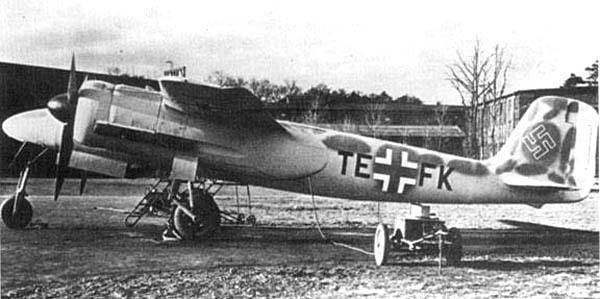
No, in general it all started with the understanding that everything was bad. Moreover, it started badly at the very beginning of the Second World War, when there was nothing to respond to the night flights of the herds of British bombers except anti-aircraft guns. The Luftwaffe did not have specialized night fighter-interceptors. There were, however, night fighters, which were made according to the leftover principle from obsolete Dornier bombers of the 15th and 17th series.
And then the British got a very fast and very wooden "Mosquito", cheap and not so good for the radars of that time. Which really started to cause such trouble that the Luftwaffe began to understand that something had to be done.
But until the appearance of "Mosquito" in the Luftwaffe belonged to the raids of the British aviation give a damn. The command sat in the bunkers, which were not afraid of the British bombs, and the population could be ...
"Not a single bomb will fall on the capital of the Reich" - this phrase was recalled to Goering until his death and even after it. They fell. And not only British and American, but also Soviet in 1941, which was quite humiliating.
But that was in 1941, and at the beginning of the war in the Luftwaffe, everyone was in complete confidence that the tactics of the blitzkrieg would make it possible to do without expensive gizmos such as heavy bombers and night fighters.
What was created by the titanic efforts of Colonel Kammhuber, could only be called night forces by such an optimist as Goering.
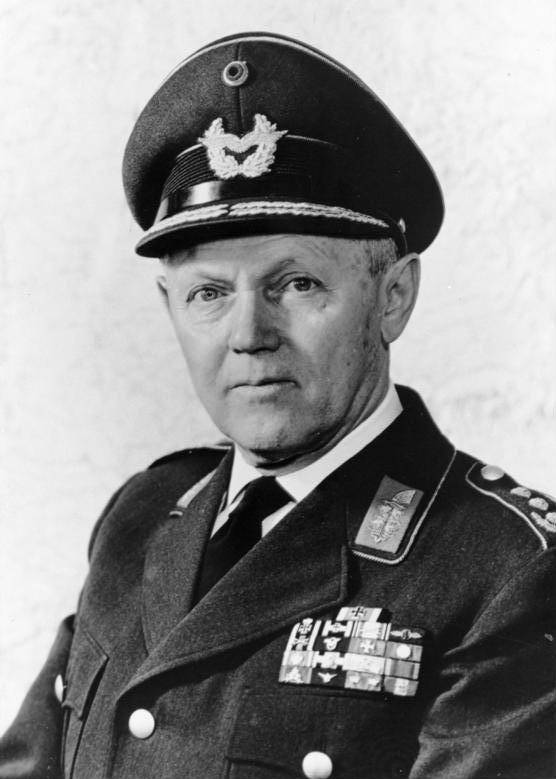
Josef Kammhuber
The night forces of the Luftwaffe, formed on the basis of the leftover principle, of course, began to pose a certain danger to British bombers, but if impartially, then exclusively due to the disgusting training of British pilots and weak weapons. Well, the German pilots did evolve.
And the tactics of the British Air Force were simple: the planes took off and flew long gut across Germany. Just spot, just catch up and intercept. That is why everyone in the Luftwaffe was happy with the fact that night fighters appeared by reworking outright junk such as Bf.110, Do.17, Do.215 and the first types of Ju-88.
Kammhuber was against this approach, but Goering was not impressed by his arguments. Why design a specialized night fighter when everything is going well anyway? Moreover, the German industry was already barely able to cope with the production of aircraft, which were lost on the Eastern Front in staggering quantities ...
And then some kind of night fighters ... Kammhuber was not lucky, the Reich Aviation Minister Udet was against the diversion of funds for "night lights", and his successor Milch too.
Well, the British quietly built four-engine bombers, and as a result, very unpleasant things began: the "Kammhuber line", his brainchild, Germany's night air defense, consisting of early warning radars, searchlight fields and anti-aircraft batteries, night fighters that were guided by radar stations - all this turned out to be unable to resist those armadas that began to appear in the sky of the Reich.
More than a thousand bombers, which on May 31, 1942, flew into Cologne, calmly did their job, and the night air defense, in general, could not oppose such a number of aircraft. 41 British aircraft, which were shot down by the combined efforts of pilots and anti-aircraft gunners, is about nothing.
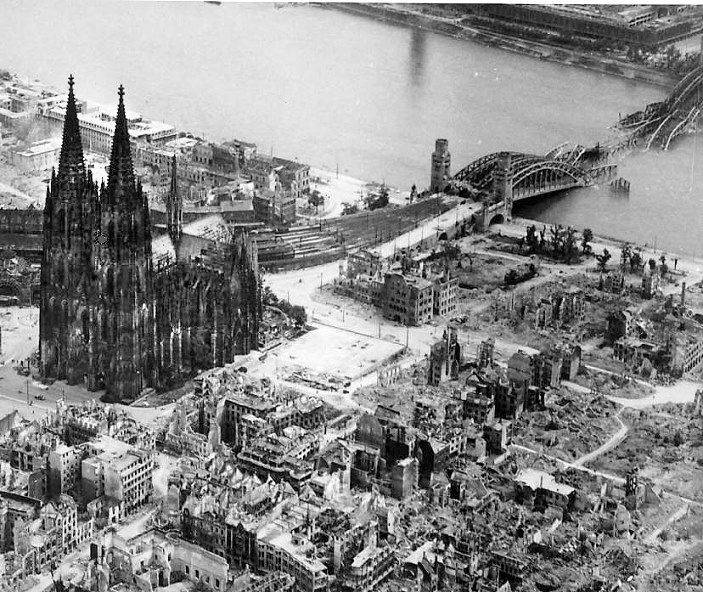
It was only then that everyone in the Luftwaffe realized that something had to be done. Yes, fighters were slowly being made for parts of the Kammhuber department, they were equipped with novelties such as Q-tubes, which caught infrared radiation from the exhaust, work was underway to install radars on "night lights". It was even said that before the appearance of new specialized vehicles, the Ju.88C was supposed to take over the role of a single night fighter.
When the Cologne bell rang out loudly, everyone in the Luftwaffe ran in search of a solution to the problem. Because everyone understood perfectly well that Cologne was just the beginning.
And they gave aviation firms assignments to develop a night fighter.
"No, well, you give ..." - answered the firms. The war was in full swing, and no one wanted to be distracted by a new project either.
“The party said - it is necessary! Who didn't understand? " Everyone understood, and work began to boil at Junkers, Focke-Wulf and Heinkel.
In fact, the Junkers took the Ju.188 project and based it on the Ju.188R night fighter. "Heinkel" extracted the project P.1060 from the archive, but everything turned out very well, turning into He.219, which we wrote about and which turned out to be just a wonderful aircraft.
By that time, the Focke-Wulf had a project of a certain analogue of the Mosquito, which Kurt Tank offered to the Ministry as a light bomber. The plane had to be wooden, so as not to burden the industry with the waste of strategic materials. This was very welcome.
In general, the success of the "Mosquito" actually gave rise to a personality cult of this aircraft. Milch decided that the Germans simply had to create something similar, but with better characteristics. Anti-Mosquito.
And then the project turned up Tank, and even based on wood, like "Mosquito". Moreover, the Germans mastered the production of Tego-Leim phenolic resin-based glue, which seemed to be not inferior in quality to the Araldite epoxy glue, which was used to glue parts of the Mosquito.
And the Ministry made a decision that the night fighter will be two-seat and twin-engined, in the long term - all-weather. He was supposed to fly for almost three hours in loitering mode. Armament was expected from four 30-mm guns, or two 30-mm and two 20-mm.
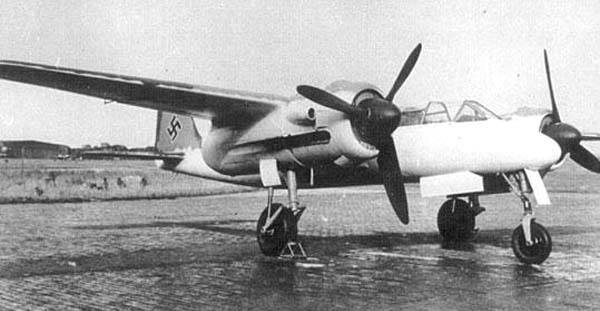
And naturally, the plane was needed yesterday. More precisely, the tests had to start in July 1943. Development started in September 1942.
Most interestingly, the Focke-Wulf designers converted the bomber into a night fighter in two weeks. Moreover, Tank's engineers even proposed two projects: one- and two-seater aircraft.
The glider met all the requirements and consisted of 57% wood, 30% steel, and only 13% were aluminum alloys and other scarce materials. Everyone at the Ministry liked everything, and Focke-Wulf received a development contract, with the order given top priority.

The aircraft project received the Ta.154 index. The design of the Ta.154 was supervised by senior engineer Ernst Nipp, assisted by chief engineer Ludwig Mittelhuder, chief aerodynamicist Gottold Matthias and enforcer Herbert Wolft.
Nipp and his team made many changes to the original design. The designers soon moved from the midplane to the high-wing. A crew of two was placed in front of one another under a single canopy. Single-fin, vertical tail was made at the same time with the fuselage, and horizontal - cantilever. The main landing gear was retracted into the engine nacelles, and instead of the tail wheel, they decided to use a nose support.
The liquid-cooled Junkers Jumo211F engines developed 1 hp at takeoff. were considered quite reliable.
Plastics began to be widely used in the assembly of prototypes. Where wood could not be used, the materials Lignofol L90 or Dynal Z5 were used, which had a modulus of elasticity close to wood.
Problems came suddenly and not from where they expected. Not worse than a cruiser, the plane began to gain weight following the implementation of all the "Wishlist" of the Luftwaffe. Even replacing the wood with plastics did not help. The engines had to be changed, because 1 hp. it was clearly not enough.
However, calculations showed that even 1 hp. the Jumo.500N engine was also lacking. The only engine that seemed to solve the problem of a heavier aircraft was the Jumo.211 with a capacity of 213 hp, but the 1 had not even completed the test cycle and there was no point in talking about installing it on a new aircraft.
Therefore, the following move was made: the car was lightened as much as possible and the Jumo.211F, with a capacity of 1 hp, was installed, on which the Ta.340 made its first flight on July 154, 1. Even two weeks ahead of the RLM deadline.
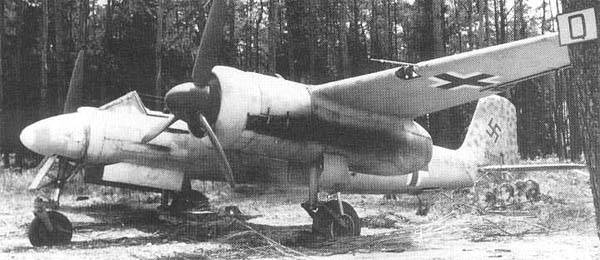
The first flight took place in the presence of Tank. The plane was piloted by the Focke-Wulf test aircraft, Hans Sander, and engineer Walter Schorn was in the operator's place. The flight was somewhat crumpled, because at first the plane began to roll to the left side. But the roll was removed with the help of trim tabs. Then the front landing gear did not retract, and then the entire landing gear retraction system failed. I had to release everything in an emergency.
However, the flight lasted for about an hour and ended without an accident. The flaws were removed and the Tank itself piloted the Ta.154 on one of the flights.
Tank and Zander noted little stick effort comparable to the FW.190, good rudder performance, and the balance of the entire vehicle in different flight modes. There were, of course, drawbacks, the main of which was a problem with the hydraulic system. Kurt Tank even completed his flight ahead of schedule precisely because the hydraulic system on the plane again failed.
There were other problems and shortcomings, but there were no critical ones. Everything was removable.
During tests, the aircraft showed a very good speed for a twin-engine fighter of 626 km / h. Do not forget that the engines were "only" 1 hp. This is the speed that was recorded in the official reports. And then some write about 340 km / h and even higher!
One of the prototypes was equipped with flame arresters for covert flight at night and the FuG212 Lichtenstein S-1 radar. So he flew even slower, since the radar antennas took another 20 km / h.
On November 24, 1943, another prototype was brought out for testing. The engines were installed Jumo211N, 1500 hp. The promised 213s were never ready. The armament consisted of four 20-mm MG151 / 20 cannons, flame arresters and a FuG.212 radar were included. The plane has grown to 8700 kg.
An attempt to install a more modern radar FuG220 "Liechtenstein" led to the loss of stability of the aircraft due to the rather impressive "Deer horns" antennas "Liechtenstein". I had to increase the keel, but it helped. The loss of stability led to the yaw of the aircraft and, accordingly, problems with aiming.
But with modernized engines, despite the losses in aerodynamics, the Ta.154 developed 620 km / h and showed decent handling.
The prototypes were sent for military trials, and the Focke-Wulf was ordered a series of 250 aircraft.
The combat use of the prototype in a specially created squadron Erprobungskommando 154 showed that four MG.151 / 20 cannons for operation on Lancaster and Halifax are definitely not enough even in the 20-mm version. Therefore, the carriages were urgently altered and a pair of Mk.108 were installed, 2-3 30-mm shells of which were enough to disable the Lancaster.
On May 6, 1944, the first loss occurred in the Ta.154 camp. A prototype that didn't have weapons, serving to test the new propulsion system, was shot down by the Lightning P-38.
Meanwhile, the situation in the skies over Germany was heating up in the truest sense of the word. The party took everything under its control, on March 1, 1944, by order of the Fuehrer, the Fighter Headquarters was formed, which was headed by one of the leaders of the Nazi party, Otto Zaur, who received the broadest powers. Zaur was able to do something to increase the production of aircraft, but all the same, the production of Ta.154 was actually hand-assembled in single quantities.
Milch, who was not very fond of Heinkel, decided to curtail the production of He.219, which had already successfully fought in the night sky of the Reich, and to produce Ta.154 and Ju.388J instead. And he did it! Despite the fact that the Ta.154 was produced individually, like the Maybachs, and the Ju.388J was generally built in one copy and passed factory tests.
Nevertheless, in May 1944, the He.219 was discontinued, even despite the protests of the pilots who liked the fighter. However, literally a month later, it became clear that neither the Ta.154 nor the Ju.388J should be expected quickly and in proper quantities, and the "Owl" went into series again.
And at the end of May, the first Ta.154s began to leave the factories. At the same time, Kurt Tank learned that the Ministry of Aviation wanted to curtail the production of Ta.154. Milch, who not so long ago opposed the He.219, now advocated the release of the Heinkel car together with the Junkers Ju.388J.
The tank did not give up. He went for a trick, inviting his friend Adolph Galland, who by that time was in command of the entire fighter aircraft of the Luftwaffe and the inspector of the night fighter aviation, Colonel Werner Streib, to personally fly the Ta-154.
June 2, 1944 both aces made one flight on the Ta-154 from the Berlin-Staaken airfield.
However, friends did not help Tank. They did not like the plane, and Galland generally said that the Ta.154, when fully loaded, would not be able to do anything with the Mosquito at all.
By the way, Galland was right, and so it happened in the end.
Then fate dealt another blow to the Ta.154 when several aircraft crashed. Proceedings began as the wings collapsed. The tank found itself at the center of a scandal and proceedings that reached the court under the leadership of Goering himself.
At the trial, it turned out that the Tank had nothing to do with it. The fault was the Kaurit glue, produced by Dynamite AG instead of the original Tego-Leim glue from Goldmann, whose factories were bombed by the allies. The glue was not quite suitable, which caused the wings to collapse. Goering apologized to Tank, who was acquitted.
At the same time, Goering learned that the Ta.154 was a night fighter, and not a high-speed bomber, which was supposed to operate over the territory of Great Britain, as the commander-in-chief of the Reich Air Force believed.
The lack of the necessary glue made the production of aircraft very difficult. But the situation itself was very unstable. Difficulties with suppliers, the allied bombing of German enterprises (from which the Ta.154 was supposed to protect), accidents - all this had a rather strong effect on the production of aircraft.
Not surprisingly, on August 14, 1944, the production of the Ta.154 was announced to be discontinued.
But even after that, Tank did not give up the struggle for his brainchild, and work on modifications of the Ta.154 was going on in the shops.
However, in November 1944 the last nail was driven into the lid of the Ta.154 coffin. This was the decree on the beginning of the implementation of the "Emergency Fighter Program", according to which the production of all twin-engine aircraft with piston engines, with the exception of the Do.335, was stopped.
A total of 31 Ta.154 aircraft were produced. Prototypes and pre-production - 21 copies and 10 serial. Some sources call the figure up to 40 cars, but in fact it is completely irrelevant.
Modifications were also developed.
Ta-154V with Jumo.211N engine. A new type of cab with a "blown" canopy and ejection seats. The armament was to consist of four 30-mm Mk.108 cannons in the nose and two of the same cannons in the Schrage Musik. As a radar was planned FuG.240 "Berlin N-1a" centimeter range with a parabolic antenna in the radome.
Ta-254. This is Ta.154C with Jumo213E engines (with three-speed two-stage superchargers and 1750 hp in takeoff mode) and GM-1 afterburner system.
It was expected that the Ta-254A-1 will reach a maximum speed of 682 km / h at an altitude of 10 m, and a single daytime Ta-590A-254 with the MW2 system - 50 km / h at an altitude of 736 m.
But of course, these planes did not go into production.
But we can say with confidence that Ta.154 still went into battle. Even in single copies. This is evidenced by both the business documents of the Luftwaffe units and the aerial photographs of German airfields taken by the British.
Ta.154, who ended up in NJG-10 and E / JG2, formed at the end of 1944 in southern Germany, could well take part in hostilities.
Feldwebel Gottfried Schneider made the first combat sortie on Ta.154 on November 19, 1944. According to some reports, Schneider shot down one Lancaster, but then the Mosquito that approached forced Schneider to retreat.
It turned out that "Mosquito" remained a tough nut to crack for Ta.154. The German fighter was unable to either catch up with the Mosquito bombers or escape the fighters. It turns out that the Ta.154 had only one option for attack - from below or from above the column of bombers. Once. Then "Mosquito" was pulled up, covering the bombers and "Focke-Wulfam" was not up to the attacks. Even good maneuverability did not help, and the speed of the British was higher.
Afterburner systems were installed on some aircraft in the field so that they could break away from British fighters.
But Ta.154 suffered the main losses during the day, on the ground, under the bombs of the allies. It was natural.
If circumstances were better, this interesting aircraft could have played a much more prominent role in the air battles over Germany. But alas, Tank failed to push the plane into production and quickly fulfill THAT order for 250 aircraft.
But this was the fate of almost all German combat aircraft, work on which went on after the start of the Second World War.
What else can you say about this plane?
The crew was very well protected. The weight of the armor that protected the cockpit was 150 kg. Frontal bulletproof glass - 50 mm, side glass - 30 mm. The seat of the RDS operator, which sat behind the pilot, facing forward during the flight, had an armored headrest. The frontal armor plate in the nose was 12 mm thick, the side armor plates were 8 mm thick.
Radio-electronic equipment.
- ultra-short-wave radio station FuG.16ZY with a radio compass unit ZVG16;
- equipment of identification "friend or foe" FuG.25a Erstling for interaction with the Wurzburg type air defense radar;
- radio altimeter FuG.101a;
- Blind landing equipment FuB.12F
- PeilG6 radio navigation system with APZ A-6 radio compass.
- Radar: FuG.212C-1, FuG.22O SN-2 or FuG.218 "Neptun".
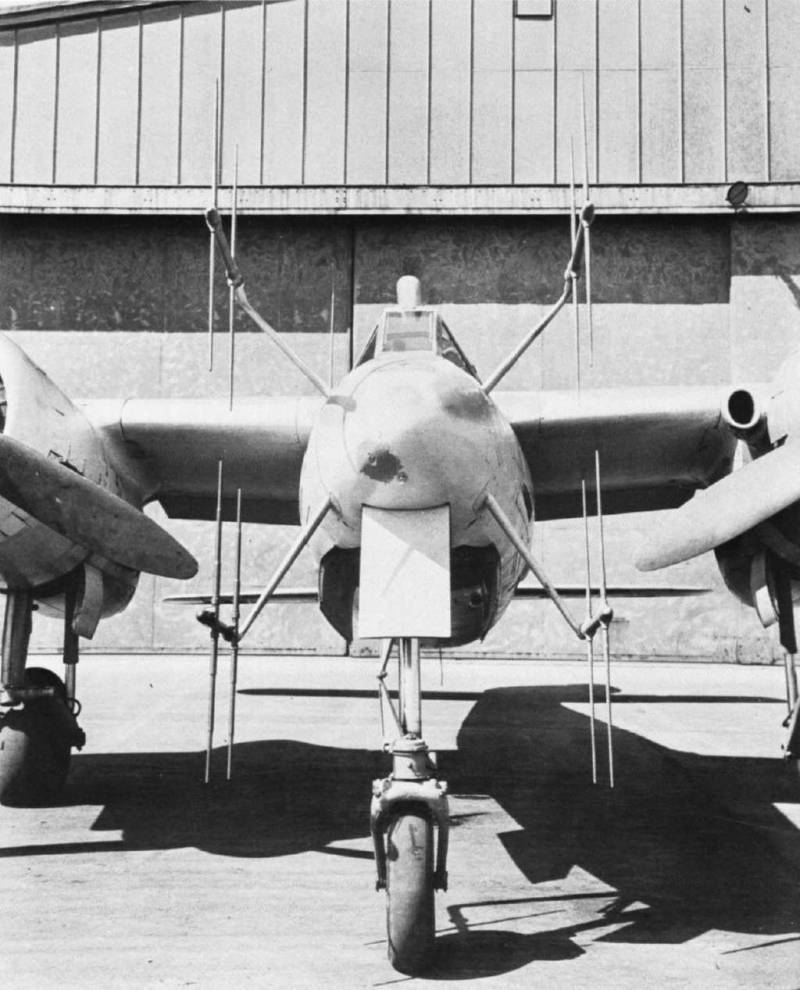
LTX Ta.154a-1
Wingspan, m: 16,30
Length, m: 12,55
Height, m: 3,60
Wing area, м2: 31,40
Weight, kg
- empty aircraft: 8 940
- normal takeoff: 8 450
- maximum take-off: 9 560
Engines: 2 х Junkers "Jumo" 213Е x 1 750 hp
Maximum speed km / h
- near the ground: 530
- at height: 646
Cruising speed, km / h: 520
Practical range, km:
- with nominal fuel: 1
- with additional tanks 2х300 l: 1 850
Rate of climb, m / min: 750
Practical ceiling, m: 10 900
Crew, prs: 2
Armament:
- two 20-mm guns MG.151 with 200 rounds per barrel,
- two 30-mm cannon MK.108 with 110 rounds per barrel.
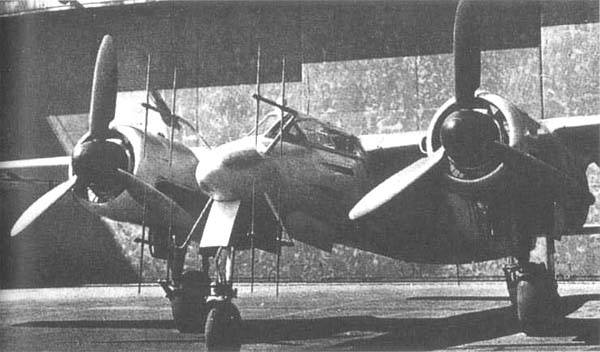
The plane was really good. But "Mosquito" was better, and No. 219 was better. The result of political machinations, Ta.154 lost even to itself in the sense that Focke-Wulf was unable to establish production in the required quantities.
The aircraft had strengths such as handling, range, good avionics and weapons.
But speed was a weak point. That is why, despite all the behind-the-scenes machinations of Kurt Tank, the plane did not become the guardian of the Reich's night sky. And no one stood up for him in the Ministry of Aviation.

So it turns out that Ta.154 lost to everyone.
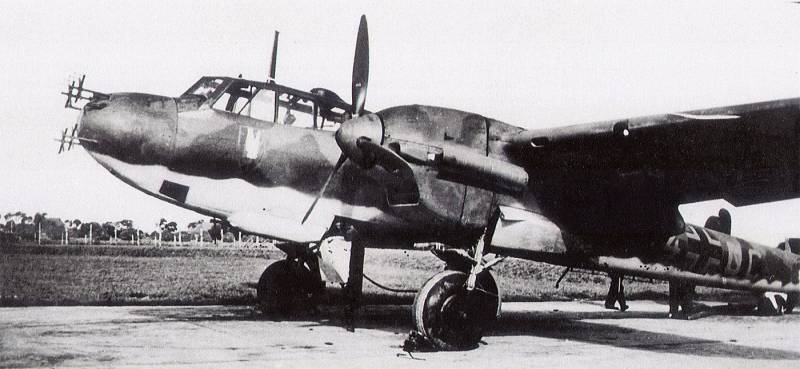
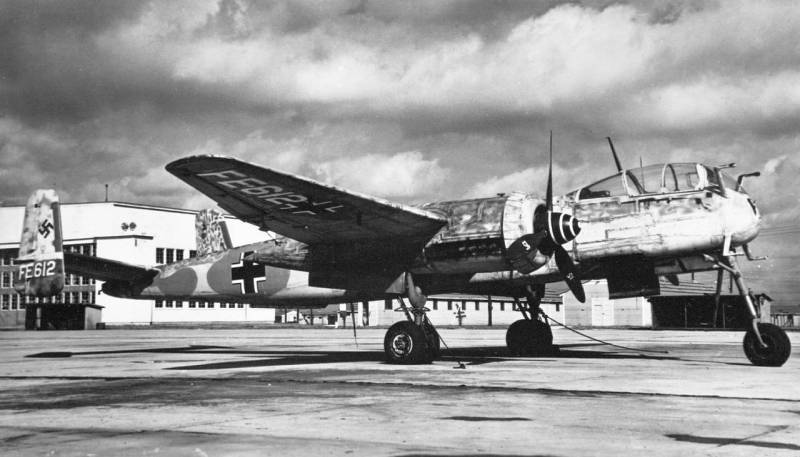
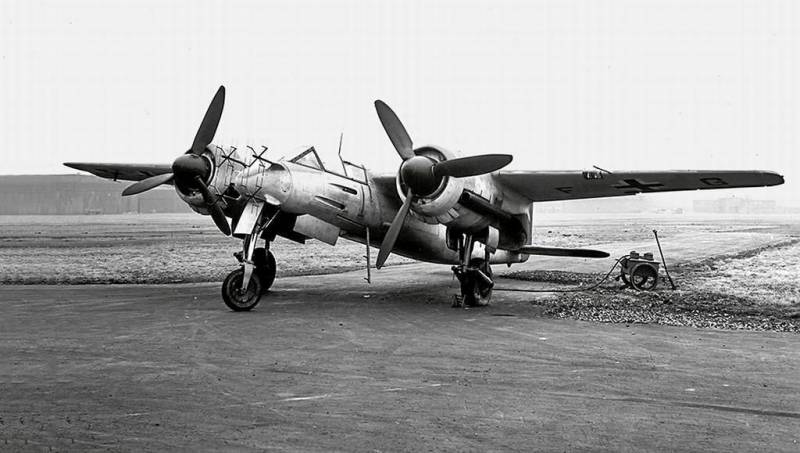
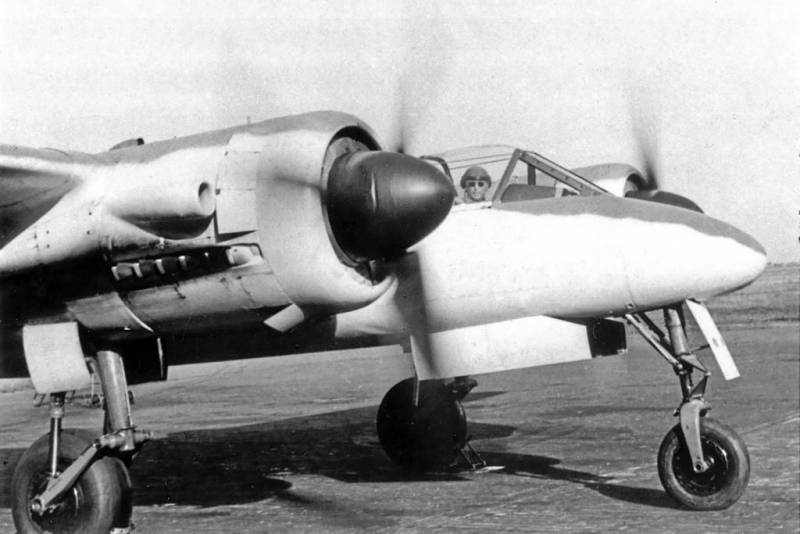
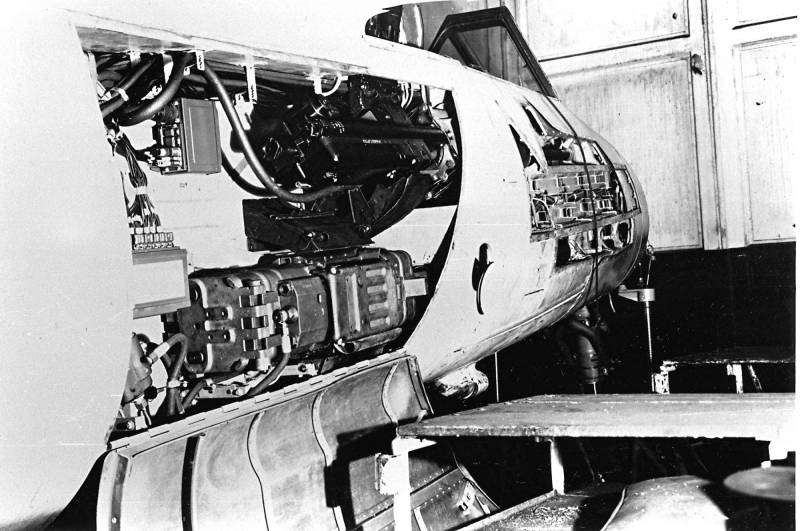
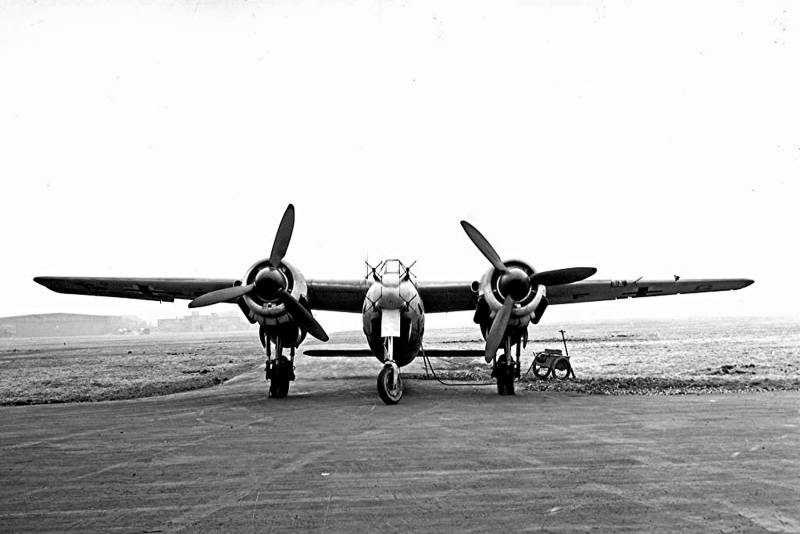
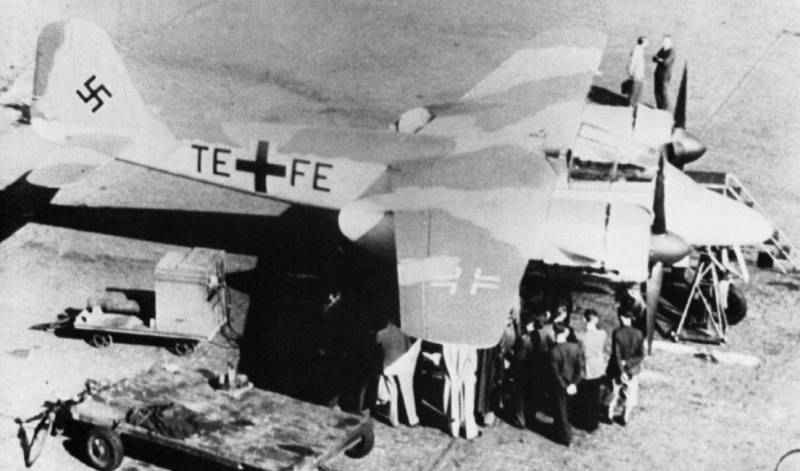

Information